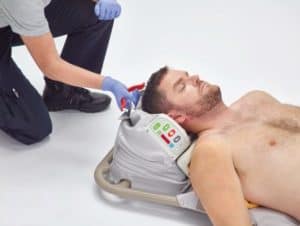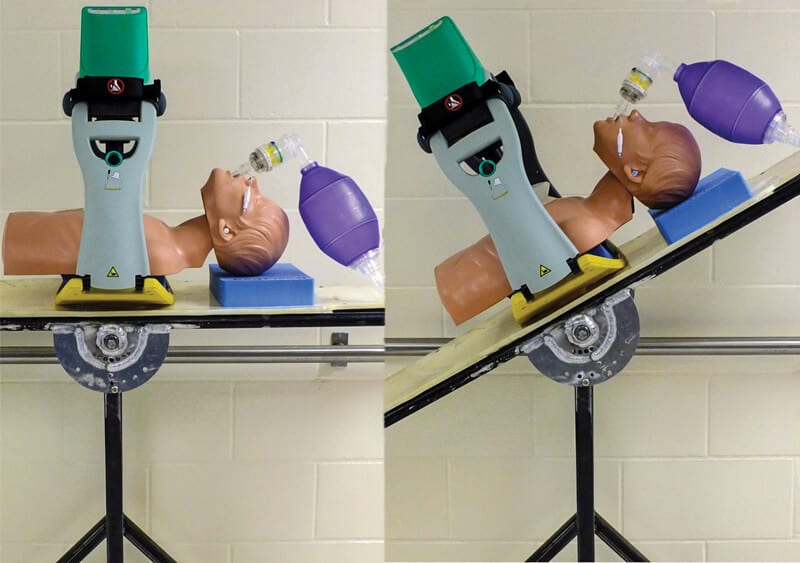
Image Source: jems.com
You may have heard of Head-Up CPR as a new approach to patient positioning during CPR. It may not be totally prime-time yet(although it is being used right now), but it is, thinking outside the box and concentrating on the most important part of what cardiac resuscitation is about…. saving the brain. If we go right back to asking “What are we trying to achieve in resuscitating patients?” The real answer is neurologically intact survivors. This is exactly what head-up CPR is about.
The initial question came from at the unexpected problem of how to transport cardiac arrest patients in South Korea, where the accommodation is high-rise buildings and the lifts are very, very small. Patients were transported with either head up or head down, purely to fit into the lifts. The question regarding which position was better had to be answered.
The initial 2014 study used a porcine model with automated CPR and an impedance threshold device. CPR was performed for 5 minutes in the supine position and then a 30 degree head tilt up and then head-tilt down was performed.
Cerebral blood flow(CBF) and cerebral perfusion pressure(CPP) were found to be higher in the head-up group. This was primarily thought to be due to gravity-dependant venous drainage from the brain, cerebral venous sinuses and the paravertebral venous plexus. Blood flow in the lungs was also thought to be redistributed, in a similar mechanism to that which results in cardiac failure patients performing better when sitting up.
Studies using a cadaver model, found similar changes in intracranial pressure(ICP) and CPP.
As an aside: CPP is mathematically derived from the Mean Arterial Pressure(MAP) and the ICP
CPP=MAP -ICP
Normal CPP in the supine patient is usually 50-70 mmHg and normal ICP is 5-15 mmHg
A higher CPP, however doesn’t always lead to improved oxygen and nutrient delivery to the brain as per the pressure vs flow argument.
Even though we need more research before we have a greater take-up of this CPR method, it has already moved from the laboratory to the real world with EMS services in Palm Beach County, USA, using it and reporting a doubling of survival rates.
A few things to remember if you are considering this:
- Circulatory adjuncts are required for CPR.
- This means that manual CPR is not used at present
- Mechanical CPR devices have been used in two studies with differing results of CPP. One study demonstrated CPP at 7% of baseline values which is considered incompatible with life.
- It is important to initially perform CPR in the supine position, prior to sitting the patient up, in order to ‘prime the cardio-cerebral circuit’. There should then be no interruption to CPR when in the head-up position
- Rapid elevation of the head may result in a significant, gravity related, drop in aortic pressure.
- The optimal head-up position hasn’t been agreed upon, however 30 degrees appears to be the adopted angle.
- Head-up rather than whole body up position should be used, to avoid venous blood pooling in the lower extremities over time.
- The location of the heart in the sitting position, may differ to that of when the patient is supine. In one study it was reported that the heart was up to 4cm superior and 4cm to the left of where expected. This may affect the positioning of manual or mechanical CPR.
This may be the next big thing. Watch this space.
References
- Debaty G et al. Tilting for Perfusion: Head-up position during cardiopulmonary resuscitation improves brain flow in a porcine model of cardiac arrest. Resuscitation. 2015;87:38
- Moore JC et al. Head and thorax elevation during active compression decompression cardiopulmonary resuscitation with an impedance threshold device improves cerebral perfusion in a swine model of prolonged cardiac arrest. Resuscitations. 2017;121:195-200.
- Moore JC et al. Head-up position lowers intracranial pressure in a human cadaver model of cardiopulmonary resuscitation. AHA Resuscitation Science Symposium and Scientific session. New Orleans 2016.
- Kim T et al. The effect of resuscitation position on cerebral and coronary perfusion pressure during mechanical cardiopulmonary resuscitation in porcine cardiac arrest model. Resuscitation 2017;113:101-107
Peter Kas










